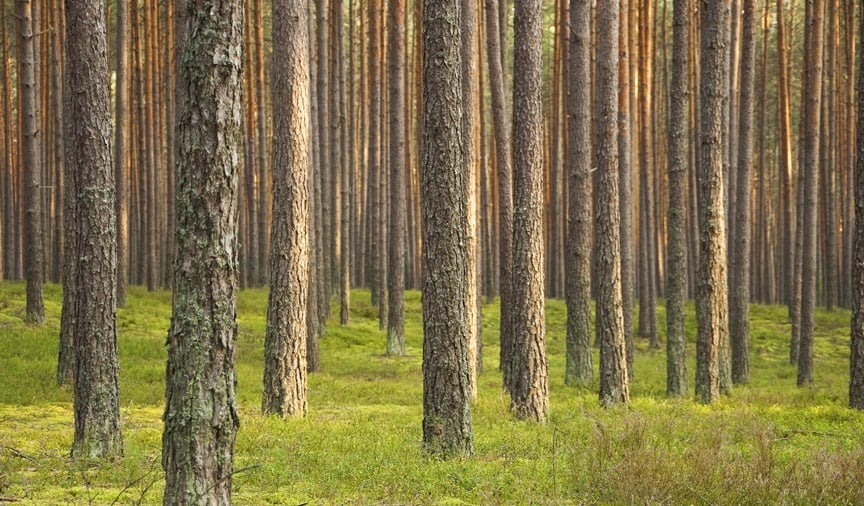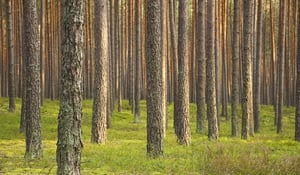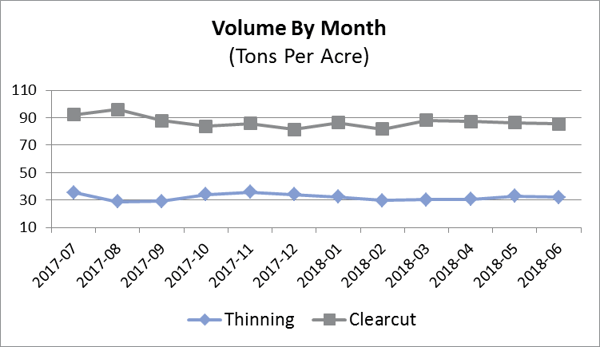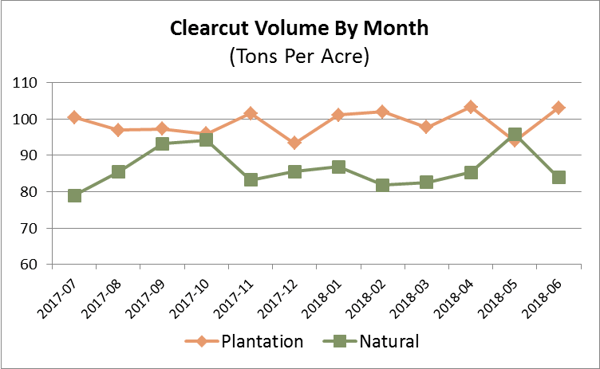
“How many tons of wood are there on an acre of land?” Irrespective of location, it’s one of the most common questions foresters hear on an almost-daily basis, and it’s also one that’s difficult to properly define, as there is simply no absolute answer. Regardless of who’s asking, my go-to answer to this question as a consulting forester has always been, “It varies considerably.”
Consumers of wood raw materials want to know the answer to this question so they can maximize efficiencies and seek out the most affordable resources, and timberland owners want to know so they can get a general estimate of how much their timber is worth. Like all resources, the law of supply and demand drives the volume and value of timber.
At a very high level, an acre of timber is an acre of timber. But regional differences in species mix, growth rates, terrain and a host of other factors oftentimes mean there is a considerable disparity in the volume, and therefore the value, of wood on an acre of land. For instance, we recently published a blog post that analyzes the difference in chip and pulpwood price trends between the US South and the Pacific Northwest.
But in the US South specifically, the factor that has the single largest impact on the volume of wood per acre is the predominant species of trees on the land: pine vs. hardwood.
When cruising a stand of timber, the volume of natural hardwood can be the toughest factor to determine due to large variations in the number of trees per acre, the tremendous inconsistency in tree sizes and the variance in quality based on the species. Even mixed stands of timber (both pine and hardwood) can have large variations due to the size of the trees, the density of trees, and the percentage of the area that is covered by pine vs. hardwood. 
Landowners in the US South that actively manage the timber on their properties typically manage for the growth of pine—usually the slash and loblolly varieties. While this minimizes diversity and significantly improves the ability to accurately determine stand volume, there is still plenty of variation due to a few important factors:
- Forest Type: A plantation-style managed property has more fixed density across the stand, depending on the desired spacing; a natural-style property is regenerated without actively planting trees, which
oftentimes leads to a much higher density of trees and more variable spacing across the stand. - Soil Quality: Lower-quality soils generally result in slower tree growth, smaller tree size and lower tree quality.
- Management Regimes: Tree spacing will contribute to individual tree growth and timber quality over the life of the stand. Density can be controlled on a plantation-style stand, as the trees are planted in rows to improve access for timberland managers, and the rows result in higher tree density: 7’ x 10’ rows (trees planted every 7’ in rows that are spaced every 10’) = roughly 620 trees per acre, and 10’ x 10’ = roughly 435 trees per acre.
- Silvicultural Applications: Mechanical or chemical site preparation, chemical release spray, prescribed burns, weed and pest control management can all result in improved survival rates and faster growth for planted pine seedlings.
- Type of Harvest: Thinning vs. clearcut: thinnings remove only a portion of the stand’s smaller trees to make more room for the other trees to grow larger, and clearcuts remove all of the trees on the stand. A pre-commercial thinning on a natural timber stand will result in greater variance in the number of trees per acre at the time of a second (commercial) thinning. Also, the total number of thinnings, volume harvested during each thinning, and the timing of each thinning in the total growth cycle will affect the overall volume on the stand.
When combining all of the above factors, it is evident that many influences contribute to the overall volume of wood on any given stand of timber in the US South.
What Does the Data Say?
It’s important to note that the sizes of the trees removed during thinnings and clearcuts are quite different. In general, the size of pine logs fall into the following categories: trees that are 5”-7” diameter at breast height (DBH) are considered “pulpwood;” logs that are 8”-11” are considered “chip-n-saw;” logs that are 12”+ in diameter are considered “sawtimber.” As logs get larger, the per-ton value of the trees increases; sawtimber that has a DBH of 18" is more valuable than 12" sawtimber, for instance.
Harvest Type
Forest2Market’s transaction-based data from actual timber sales throughout the US South over the last year (7/17 - 6/18) helps us answer the larger question. Clearcut harvests will remove trees in all three categories noted above, whereas thinnings will remove only pulpwood and smaller logs that fall into the chip-n-saw category. Detailed data by harvest type, predominately from pine stands, demonstrate that:
- Clearcut harvests generate roughly 80-105 tons of timber per acre
- Average clearcut tons per acre: 87
- Thinning harvests generate between 25-40 tons of timber per acre
- Average thinning tons per acre: 32
- Average thinning tons per acre: 32

Timberland Type
Timberland type also plays a significant role in the total tons per acre at harvest. Plantations typically maintain a higher volume per acre because they are harvested before growth begins to slow down drastically (35+ years old). On stands that are thinned and harvested at a younger age, there is less mortality because they experience less hardwood competition due to silvicultural prescriptions. Forest2Market data from timberland type demonstrate that:
- Average volume of natural pine clearcut: 86 tons per acre
- Average volume of plantation pine clearcut: 99 tons per acre
The following chart specifies the volume trend for both natural and plantation pine.

A trained forester is essential to help determine an accurate amount of wood on an acre of timberland. In the follow-up installment to this blog post, I will dig deeper into this common question and analyze actual timber prices in conjunction with tons of wood per acre. Combining Forest2Market’s direct market pricing data and harvest volume information will help to illustrate the real value of an acre of timber.





